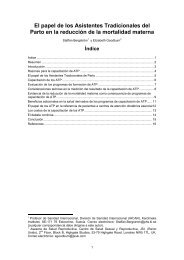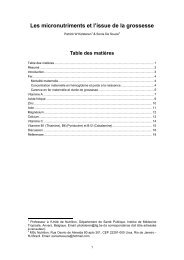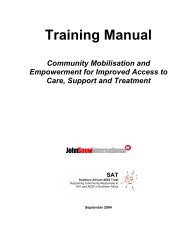Situational assessments <strong>of</strong> <strong>males</strong> <strong>who</strong> <strong>have</strong> <strong>sex</strong> <strong>with</strong> <strong>males</strong> from 4 cities <strong>in</strong> India and Bangladesh 2000The average number <strong>of</strong> paid <strong>sex</strong> acts <strong>in</strong> the previous month per respondent <strong>who</strong> was paid for<strong>sex</strong> was approximately 40 <strong>in</strong> Hyderabad, 20 <strong>in</strong> Bangalore, 17 <strong>in</strong> Pondicherry and 106 <strong>in</strong>Sylhet. Around 52%-54% <strong>of</strong> these acts <strong>in</strong> each city <strong>in</strong>volved receptive anal <strong>sex</strong>.Condom usage <strong>in</strong> the most recent 5 paid <strong>sex</strong> acts was reported as “never” by 40% <strong>in</strong>Hyderabad, 34% <strong>in</strong> Bangalore, 92% <strong>in</strong> Pondicherry and 52% <strong>in</strong> Sylhet. It was reported as “alltimes” by 12% <strong>in</strong> Hyderabad, 27% <strong>in</strong> Bangalore, 1% <strong>in</strong> Pondicherry and 9% <strong>in</strong> Sylhet.[Please see Annex 1 Data: 3A, 3B, 3C, 3D,3E,3F, 4A, 4B, 4C, 4D]6.1.5 Marriage and female partners <strong>of</strong> <strong>males</strong> <strong>who</strong> <strong>have</strong> <strong>sex</strong> <strong>with</strong> <strong>males</strong>Most <strong>of</strong> the respondents <strong>in</strong> the assessments reported they were married or would <strong>have</strong> tomarry at sometime <strong>in</strong> the future. At the time <strong>of</strong> the assessment <strong>in</strong> Hyderabad 25% werealready married, <strong>in</strong> Bangalore 30%, <strong>in</strong> Pondicherry 26% and <strong>in</strong> Sylhet 22%.marriage is a social, cultural and religious necessity, a central issue <strong>with</strong><strong>in</strong> people'slives and a ma<strong>in</strong>stay <strong>of</strong> family and community life...Marital status signifies adulthood,social responsibility…The majority <strong>of</strong> kothis and their <strong>sex</strong> partners…accepted the socialnecessity <strong>of</strong> compulsory marriage…There appeared to be a fatalism operat<strong>in</strong>g here,and a sense <strong>of</strong> not be<strong>in</strong>g able to challenge family and society's strictures.(F<strong>in</strong>al Report p.9)The central objective <strong>of</strong> marriage is the production <strong>of</strong> children, specifically male children… Sex <strong>with</strong> ones wife is <strong>of</strong>ten seen as a duty, rather than as pleasure. The statement "Ido duty to my wife" is quite common, mean<strong>in</strong>g I <strong>have</strong> <strong>sex</strong> <strong>with</strong> my wife. Also ask<strong>in</strong>gone's wife to perform certa<strong>in</strong> <strong>sex</strong>ual acts, such as oral <strong>sex</strong> or anal <strong>sex</strong> becomesshameful. She is the vessel <strong>of</strong> one's children. ..this <strong>of</strong>ten lead to a concept <strong>of</strong> <strong>sex</strong>ualpleasure <strong>of</strong> men as only available outside <strong>of</strong> marriage. Others would be asked toperform <strong>sex</strong> acts that could not be asked <strong>of</strong> a wife. (F<strong>in</strong>al Report. p.41)Assessment respondents reported quite high levels <strong>of</strong> <strong>sex</strong>ual activity <strong>with</strong> their wives. InBangalore and Hyderabad a majority <strong>of</strong> <strong>males</strong> reported 11 – 20+ <strong>sex</strong>ual <strong>in</strong>teractions <strong>with</strong> theirwives <strong>in</strong> the previous month. In Pondicherry the level was 29%. Some <strong>males</strong> reported thatthey had expected when they married that their <strong>sex</strong>ual <strong>in</strong>teractions <strong>with</strong> <strong>males</strong> might stop ordecl<strong>in</strong>e. However, most reported that for various reasons they still wanted to, and did, <strong>have</strong><strong>sex</strong> <strong>with</strong> <strong>other</strong> <strong>males</strong>.If you add estimates <strong>of</strong> the numbers <strong>of</strong> wives and female <strong>sex</strong> partners <strong>of</strong> these <strong>males</strong> <strong>who</strong><strong>have</strong> <strong>sex</strong> <strong>with</strong> <strong>males</strong> to the “guesstimates” <strong>of</strong> amount <strong>of</strong> male to male <strong>sex</strong> listed <strong>in</strong> section6.1.2 above then you <strong>have</strong> identified a very large number <strong>of</strong> the <strong>sex</strong>ually active adults <strong>in</strong> any<strong>of</strong> the four cities.This is part <strong>of</strong> the scenario that the assessments argue <strong>in</strong> terms <strong>of</strong> male to male <strong>sex</strong> hav<strong>in</strong>g agreater significance <strong>in</strong> HIV/STI transmission than is currently acknowledged.[Please see Annex 1 Data: 5A, 5B, 5C, 5D]6.1.6 Family and religionRespondents reported family ties and obligations as very important. The family is seen as amutual support system.Both H<strong>in</strong>dus and Muslims expressed similar sentiments about family and socialexpectations, <strong>of</strong> perform<strong>in</strong>g as men, fulfill<strong>in</strong>g duties, ma<strong>in</strong>ta<strong>in</strong><strong>in</strong>g family honour, <strong>of</strong>10Situational assessments undertaken by Naz Foundation International, funded by FHI/<strong>Asia</strong>.Paper prepared for publication by JSI UK, funded by DFID India.
Situational assessments <strong>of</strong> <strong>males</strong> <strong>who</strong> <strong>have</strong> <strong>sex</strong> <strong>with</strong> <strong>males</strong> from 4 cities <strong>in</strong> India and Bangladesh 2000marry<strong>in</strong>g and produc<strong>in</strong>g children, particularly sons. Choice <strong>of</strong> marriage partner was stillseen as a parental duty, and separation from the family as not an option.(F<strong>in</strong>al Report p.9)The assessments did not directly ask questions about the <strong>in</strong>fluence <strong>of</strong> religion but it wasraised as an issue by respondents. They could not name specific parts <strong>of</strong> H<strong>in</strong>du or Islamictexts that prohibited <strong>sex</strong> between <strong>males</strong> but they had a general feel<strong>in</strong>g that their religioncondemned this behaviour. This added to feel<strong>in</strong>gs <strong>of</strong> shame and exclusion.All those <strong>in</strong>terviewed pr<strong>of</strong>essed affiliation to a specific religious tradition [and] acceptedtheir specific religious traditions. None could conceive anyth<strong>in</strong>g else…….Yet theserespondents found ways to balance their <strong>sex</strong>ual practices, identities and desires <strong>with</strong><strong>in</strong>the context <strong>of</strong> be<strong>in</strong>g a H<strong>in</strong>du or a Muslim, or a Christian. Whilst many <strong>of</strong> those <strong>who</strong>identified as kothi would speak <strong>of</strong> shame, guilt, dishonour, they also believed that whatthey were, <strong>who</strong> they were, and what they did, was between themselves and God.Religious belief was still important to them and a central part <strong>of</strong> their self def<strong>in</strong>ition.(F<strong>in</strong>al Report. p.46)The family and religious organisations are critical social <strong>in</strong>stitutions that can affect these<strong>males</strong>’ self-esteem and through that their vulnerability and risk-tak<strong>in</strong>g behaviours <strong>in</strong> regard toHIV /STIs.6.1.7 Psycho-<strong>sex</strong>ual issuesIn the assessment reports these issues are seen ma<strong>in</strong>ly as the myths, beliefs and practicesthat result from lack <strong>of</strong> knowledge and that produce considerable psychological disturbanceabout <strong>sex</strong>ual matters. These <strong>in</strong>clude issues such as masturbation, penis size and shape andvirility.The <strong>other</strong> major issue raised through the assessments relates to the very high levels <strong>of</strong>shame and stigma that some <strong>males</strong> face surround<strong>in</strong>g their desire, identity and behaviour. Thisis known from studies <strong>in</strong> <strong>other</strong> countries to contribute significantly to low self-esteem andhigher levels <strong>of</strong> risk-tak<strong>in</strong>g behaviour. (source) While this l<strong>in</strong>k is not directly demonstrated <strong>in</strong>these reports it appears highly likely and would benefit from further detailed behaviouralresearch.6.1.8 Inject<strong>in</strong>g drug use among <strong>males</strong> <strong>who</strong> <strong>have</strong> <strong>sex</strong> <strong>with</strong> maleThis was not a direct focus <strong>of</strong> the assessments. However, 9% <strong>of</strong> respondents <strong>in</strong> the threecities <strong>in</strong> India reported <strong>in</strong>ject<strong>in</strong>g drugs at least once <strong>in</strong> the previous 12 months.6.2 HIV / STI vulnerability and risk tak<strong>in</strong>gThe greatest vulnerability and level <strong>of</strong> risk tak<strong>in</strong>g identified <strong>in</strong> the assessments was for lower<strong>in</strong>comekhotis <strong>who</strong> sold <strong>sex</strong>. The factors lead<strong>in</strong>g to this conclusion <strong>in</strong>cluded:• low self-esteem;• low <strong>in</strong>come;• low education;• high frequency <strong>of</strong> receptive anal <strong>sex</strong>;• high frequency <strong>of</strong> partners;• access to partners from a broad social range;• very limited condom use;• limited access to <strong>in</strong>formation; and11Situational assessments undertaken by Naz Foundation International, funded by FHI/<strong>Asia</strong>.Paper prepared for publication by JSI UK, funded by DFID India.






